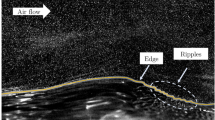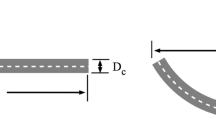Abstract
Planar imaging of flow scalars is widely used in fluid mechanics, but the effects of imaging system blur on the measured scalar and its gradients are often inadequately quantified. Here, we present a 1-D analytical study that uses simplified models of the scalar profiles and imaging system blur to estimate the measurement errors caused by finite resolution. One objective of this paper is to give the experimentalist a methodology for quantitatively assessing the impact of imaging system blur on the accuracy of scalar measurements. The scalar profiles are modeled as either error or Gaussian functions, and the imaging system resolution is cast in terms of the line-spread function (LSF), which is modeled as Gaussian. The analysis gives the errors induced in the scalar structure thickness, gradient, and dissipation, for varying degrees of blur, the latter of which is quantified by σ, the standard deviation of the Gaussian LSF. The results show that, to keep errors in the peak scalar gradients and dissipation to less than 10%, the 20%-width of the scalar structures should be at least 7.5σ. Typical flow imaging experiments require fast (i.e., low f/#) optics that may suffer from significant blur and, therefore, this requirement may be difficult to meet in many applications. It is also shown that the resolution requirements for measuring the dissipation are more restrictive than for structure thicknesses. Further simulations were made to assess the effects of having clustered, or closely spaced, dissipation structures. Compared to the single structure results, there is a less severe resolution requirement to obtain scalar structure length scales, but a more severe requirement on the scalar gradient and dissipation.












Similar content being viewed by others
References
Buch KA, Dahm WJA (1996) Experimental study of the fine-scale structure of conserved scalar mixing in turbulent shear flows. Part 1. Sc>>1. J Fluid Mech 317:21–71
Buch KA, Dahm WJA (1998) Experimental study of the fine-scale structure of conserved scalar mixing in turbulent shear flows. Part 2. Sc ≈ 1. J Fluid Mech 364:1–29
Chazallet F, Glasser J (1985) Theoretical bases and measurement of the MTF of integrated image sensors. In: Granger EM, Baker LR (eds) Image quality: An overview. P Soc Photo-Opt Inst 549:131–144
Clemens NT (2002) Flow imaging. In: Hornak JP (ed) Encyclopedia of imaging science and technology. John Wiley and Sons, New York, pp 390–419
Dahm WJA, Southerland KB (2000) Quantitative flow visualization via fully-resolved four-dimensional spatio-temporal imaging. In: Smits AJ, Lim TT (eds) Flow visualization: Techniques and examples. Imperial College Press, London, pp 289–316
Donbar JM, Driscoll JF, Carter CD (2000) Reaction zone structure in turbulent nonpremixed jet flames - From CH-OH PLIF images. Combust Flame 122:1–19
Kychakoff G, Howe RD, Hanson RK (1984) Quantitative flow visualization technique for measurements in combustion gases. Appl Opt 23(5):704–712
Long MB (1993) Multidimensional imaging in combusting flows by Lorenz-Mie, Rayleigh and Raman scattering. In: Taylor AMKP (ed) Instrumentation for flows with combustion. Academic Press, London, pp 467–508
Lucke RL (1998) Deriving the Coltman correction for transforming the bar transfer function to the optical transfer function (or the contrast transfer function to the modulation transfer function). Appl Opt 37(31):7248–7252
Mi J, Nathan GJ (2003) The influence of probe resolution on the measurement of a passive scalar and its derivatives. Exp Fluids 34:687–696
Miles RB, Lempert WR (1997) Quantitative flow visualization in unseeded flows. Ann Rev Fluid Mech 29:285–326
Paul PH (1991) The application of intensified array detectors to quantitative planar laser-induced fluorescence imaging. In: 27th joint propulsion conference, Sacramento, CA, June 1991, AIAA 91–2315
Paul PH, van Cruyningen I, Hanson RK, Kychakoff, G (1990) High resolution digital flowfield imaging of jets. Exp Fluids 9:241–251
Pitts WM, Richards CD, Levenson MS (1999) Large- and small-scale structures and their interactions in an axisymmetric jet. National Institute of Standards and Technology, NISTIR 6393
Primot J, Chambon M (1997) Modulation transfer function assessment for sampled imaging systems: Effect of intensity variations in periodic thin-line targets. Appl Opt 36(29):7307–7314
Rogers GL (1998) Measurement of the modulation transfer function of paper. Appl Opt 37(31):7235–7240
Seitzman JM, Hanson RK (1993) Planar fluorescence imaging in gases. In: Taylor AMKP (ed) Instrumentation for flows with combustion. Academic Press, London, pp 405–466
Smith WJ (2000) Modern optical engineering: The design of optical systems, 3rd edn. McGraw-Hill, New York
Su LK, Clemens NT (1999) Planar measurements of the full three-dimensional scalar dissipation rate in gas-phase turbulent flows. Exp Fluids 27:507–521
Tsurikov MS (2002) Experimental investigation of the fine scale structure in turbulent gas-phase jet flows. PhD dissertation, The University of Texas at Austin
Williams TL (1999) Optical transfer function of imaging systems. Institute of Physics Publishing, Bristol, England
Acknowledgements
This work was sponsored by the National Science Foundation under grant CTS-9977481.
Author information
Authors and Affiliations
Corresponding author
Rights and permissions
About this article
Cite this article
Wang, G.H., Clemens, N.T. Effects of imaging system blur on measurements of flow scalars and scalar gradients. Exp Fluids 37, 194–205 (2004). https://doi.org/10.1007/s00348-004-0801-7
Received:
Accepted:
Published:
Issue Date:
DOI: https://doi.org/10.1007/s00348-004-0801-7




